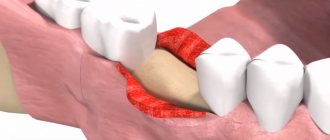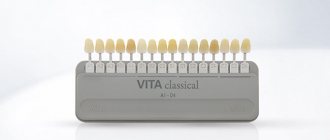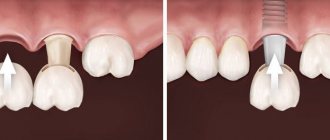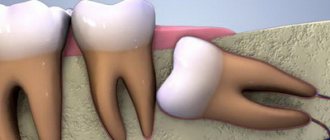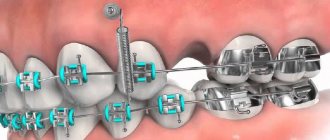Chief physician
German Implantology Center - Magomed Dakhkilgov, maxillofacial surgeon, implantologist, orthopedist Please note that the German Implantology Center is an official and certified partner of all leading and world-recognized implant systems. We are one of the key partners in Russia precisely because of our enormous professionalism and accumulated practical experience of successful many years of work in installing implant systems of all configurations - from single implantations to total ones.
This will ensure you receive excellent service and reliability from your front dental implants in both the short and long term. We were one of the first in Russia to begin installing zirconium dioxide implants, which have a number of advantages over classic titanium implants, primarily due to their aesthetics and strength. Especially when it is necessary to carry out implantation in the area of the front missing or replaced teeth:
Remember one simple truth: an implant is installed once and for life
:
Causes and consequences of tooth loss in the front
Most people at one stage or another in their lives have encountered the problem of tooth loss - adentia. The reasons for the occurrence of such a defect in the dentition can be very different:
- insufficient oral hygiene: leading to the destruction of dental crowns and/or severe gum disease,
- untimely treatment of caries: entails pulpitis, periodontitis, cyst formation, granulomas on the roots,
- jaw injuries: the smile area is most often injured,
- inflammatory diseases in the nasal sinuses: inflammation can be transmitted to the roots of the upper dentition (since the border of the sinuses is located very close to them),
- eating foods that destroy tooth enamel: for example, large amounts of sour fruits and juices,
- bad habits: for example, smoking (in general, it is harmful to all tissues of the jaw system),
- biting hard foods, and sometimes even inappropriate use of the front teeth - biting on any hard objects, toys (especially important for children).
If even one tooth is missing, a late visit to the dentist inevitably entails a number of problems. First of all, the bite is disrupted: neighboring teeth begin to shift towards the missing one, the dentition becomes curved, the tooth on the opposite jaw moves out of the bone socket, which can also lead to its loss over time. The more pronounced the adentia, the more the bite situation worsens.
The absence of one or more front teeth not only leads to disruption of chewing function and bite, but also affects a person’s psychological well-being. People who have problems with smiling become more withdrawn, smile less, communicate less, trying not to draw attention to their aesthetic defects. For people in public professions, the “loss” of attractive appearance is especially critical.
The best solution for losing front teeth is implantation. It involves restoring the tooth root, as well as installing a crown on top of the implant, resulting in a completely physiological replacement of natural with artificial. It is almost impossible to distinguish one from the other! And you can evaluate the quality of the implantation of the front teeth in the photo “before and after” treatment - the restorations look very natural, like your own.
Content
- Why restore lower teeth?
- Features of implantation
- Implantation of lower anterior teeth
- Implantation of lower molars
- How many implants are needed?
The lower jaw is a movable area directly responsible for opening the mouth. There is a dense, strong and wear-resistant jawbone. When chewing, the lower jaw experiences the highest load - up to 40 kg per tooth. This function is reflected in their appearance - with a wide chewing surface and a tendency to develop caries. The lower teeth are more susceptible to caries, since their location and structure creates difficulties for quality cleaning. Also characteristic is the formation of secondary caries, under a crown or filling, which often becomes the reason for tooth extraction. In the case of incomplete dentition, the work of the jaw cannot be called complete. The best way to restore functionality is to implant the lower chewing teeth.
PROMOTION
Osstem dental implantation turnkey
18,000 rub.
Advantages of implantation over classical prosthetics
The main advantage of implanting the front upper or lower teeth is the ability to install single crowns on implants (rather than a bridge). By restoring the anatomical structure of a natural tooth root using an implant, you can achieve ideal results:
- reliability and durability: the natural and full functionality of the dentition is restored. Implants are made of biocompatible high-strength titanium, which allows them to last for decades, while the bone tissue around the implants does not atrophy, since the chewing load enters the bone through the implants, as through natural roots. As for crowns on implants, the patient can choose metal-ceramics - it lasts about 15 years, is quite durable and aesthetic, or zirconium and aluminum oxide - the most modern materials, the most durable, highly durable,
- comfort in use: dentures on implants not only look, but also feel natural, and caring for them is no more difficult than caring for natural teeth;
- natural spaces between the teeth are preserved: artificial crowns on implants are located at a short distance from each other, and are not combined with each other, as with bridge prosthetics, which also adds naturalness to the entire dentition,
- the natural contour of the gum around the crown is preserved: it is formed thanks to orthopedic components that are placed on the implant during its fusion with the bone (in the smile zone, the abutment performs the function of a gum former),
- the neighboring teeth are not injured: with the help of implants, only missing teeth can be restored, without injuring (without grinding down) the neighboring healthy ones.
Gum plastic surgery after implantation of the front teeth or the formation of a beautiful gum contour is carried out using an abutment (although usually, if the tooth is out of sight, a gum former is used). This orthopedic component has a rounded shape and a diameter close to the diameter of the future crown. The denture will be installed in such a way that its lower part will cover the aesthetic gingival margin.
How to walk with front tooth implantation?
If we talk about installing a crown on an implant in one visit, then it is possible, but not in all cases. If there are contraindications, so that the patient does not go without a tooth, we install an immediate prosthesis instead of a crown, which is fixed on the teeth adjacent to the “missing” and does not damage the soft tissues. Perhaps this type of prosthesis is not a masterpiece of aesthetics, but it does its job well - it replenishes the dentition, and it looks good. In addition, the patient will not have to wear it for a long time - a maximum of four months, after which the prosthesis will be replaced with a permanent crown.
How to place implants in the anterior region - methods and stages of installation
There are 3 main types of implantation of anterior teeth: classical implantation with delayed loading and express implantation with immediate loading; there is also implantation with early loading. Let us consider the features of these methods further.
Option 1: Classic two-stage implantation with delayed loading
New teeth in 1 day - All-ON-4 - 180,000 rub.
All inclusive!
3D modeling of the structure with a prosthesis, implantation of 4 Osstem implants, installation of a fixed prosthesis on the same day. Free consultation with an implantologist +7 (495) 215-52-31 or write to us
Classical implantation consists of two main stages:
- the surgical stage is the installation of the implant itself: then you need to wait for the implant to engraft into the bone, which takes approximately three to six months. During this time, the patient can have a temporary removable crown installed to hide the defect in the dentition. A limited chewing load should be transferred to the implant that has not taken root, so the crown is slightly removed from the bite, relieving pressure on the intraosseous part,
- prosthetics: after the implant has firmly taken root in the bone (after 3-6 months), you can proceed to the second stage - prosthetics. To do this, an abutment is installed on the implant - the top of the implantation system, which will first serve as a gum former (so that there is a beautiful and natural gingival contour around the future crown). Subsequently, the abutment will support the crown. The abutment can be either metal (gray or gold) or white zirconium dioxide for high aesthetic requirements. Next, impressions are taken, and after a few days the finished permanent crown is fixed to the implant.
Option 2: Express implantation with immediate loading
Implantation with immediate loading is also called one-stage, since all stages are carried out one after another without a long wait for the implant to engraft into the bone tissue. But this method is not suitable when restoring 1-2 teeth, because with immediate loading, the implants are splinted with an extended prosthesis, otherwise they will move. A single crown or bridge-like prosthesis in an aesthetically significant area is not capable of splinting implants. That is, one-stage protocols with immediate loading can only be used if a completely edentulous jaw or segment of the masticatory zone is being restored.
The immediate load implantation process is as follows:
- installation of artificial roots: can be used as classic two-part structures (implant + abutment), as well as one-piece one-piece structures, when the tip of the implant remains above the gum during installation (as an abutment).
- Next, the doctor immediately takes impressions to make the prosthesis: well-equipped clinics use an intraoral 3D scanner, digital software, and modeling of a new smile in accordance with the “golden ratio” to create prosthetics. The data is sent to special robotic high-precision equipment in the dental laboratory. As soon as the product is ready, the prosthetics stage begins,
- installation of the denture a maximum of 72 hours after the surgical stage: and the patient can begin to chew with a full-fledged denture on the first day.
Thus, the total period of implantation with immediate loading is limited to only a few days, but do not forget that in the future it will be necessary to replace the adaptive prostheses with permanent ones.
Option 3: Early loading of implants in the smile area
Here, a permanent crown will not be placed immediately after implantation, but there is also no need to wait 3 or more months. On average, a permanent crown is placed 6-8 weeks after the surgical stage (and before that you need to wear a temporary plastic one). Early prosthetics are possible if a special progressive implant is installed - with an active surface or nanostructures that accelerate the growth of new bone on the surface of the implant and its secondary stabilization (osteofixation) by 2-3 times.
Dental implantation using the Osstem system = 70,000 rubles.
All inclusive, treatment guaranteed!
Premium implants at an affordable price. Free consultation with an implantologist +7 (495) 215-52-31 or write to us
Which clinic to choose
You can get dental implantation in Moscow at one of the ROOTT MCDI clinics. Installation of a two-stage ROOT implant (Switzerland) at the Moscow Center for Dental Implantology will cost 32,000 rubles. (excluding the cost of the crown), express implantation ROOTT – 44,000 rubles. (together with a temporary crown). You can learn more about the implantation technologies used in order to choose the most preferable option and have an idea of what to be prepared for at a free consultation with an implantologist. Appointments can be made by phone or online.
Modern dentistry offers a number of methods that give patients a chance to regain their beautiful smile. Every year, implant treatment becomes more popular and accessible.
In some cases, when it is necessary to remove a patient's own tooth, most often in the case of front teeth, dentists have the option of inserting an implant into the socket immediately after extraction. Then a “temporary” crown can be installed, thanks to which the patient maintains dental aesthetics, speech and chewing function. After about three months, the temporary crown is replaced with a permanent one, made by a technician in a laboratory. Single-stage implants themselves are slightly different in price from those that are loaded with delayed loading.
You can get advice from experienced specialists about dental implantation in the smile zone in the capital’s dental clinics:
| Clinic address | Clinic | Price |
| Dentistry ROOTT |
|
| Moscow, Kolpachny lane, 6, building 4. | Dentistry Sandora |
|
| Dentistry Prosmail.RU |
|
| Moscow, metro station "Butyrskaya", Rustaveli Street, building 15 | Dental Clinic Dention |
|
| Moscow, metro station Barrikadnaya st. Zoologicheskaya, 2, under. 9 | Dentistry DENTAL DREAM |
|
| Moscow, Zvenigorodskoye sh., 7 | Dentistry Implant Expert | Nobel implantation, USA, from 50,000 rubles, Astra Tech implantation, Sweden from 47,200 rubles, OSSTEM Korea - 27,000 rubles |
| Moscow, Bolshoi Sergievsky lane, 5 | Dentistry Viva-dent | Dental implantation depending on complexity: 31,000 - 41,000 rubles per 1 tooth |
| Moscow, st. Molodtsova, 2a | Family discount dentistry | Implantation is carried out using various systems - Astra Tech (Sweden), Ankylos Densply (Germany), Dentium (Korea), the price for 1 restored tooth is from 30,000 rubles. |
| Moscow, Paveletskaya sq., 1 | Dental Clinic Denta VIP | Implantation of the IMPLA system (Germany), OSSTEM (Korea) - from 36,000 rubles. Astra Tech (Sweden) – from 45,000 rubles. |
| Moscow, st. Lyublinskaya, 161 | Dentistry PRESIDENT |
|
Dental implants are the latest technologies that provide exceptional comfort of use. Patients who have lost their front teeth due to an accident, tooth decay, or other diseases can enjoy the ability to function normally and smile without fear, without discomfort, thanks to dental implants. The most modern method of replacing missing teeth is implantation.
Dental implants are placed when we lose our natural teeth. Most often, the decision to replace missing front teeth is made for aesthetic reasons. It's no secret that missing teeth can lead to changes in our appearance, or rather, facial features. You can see the appearance of your cheeks, mouth and nose change. Wrinkles appear faster in the middle part of the face, which makes us feel unattractive.
However, it is worth remembering that from a medical point of view, the replacement of missing teeth, both front and back, is very important. The absence of teeth disrupts the functioning of the chewing system, which over time affects both aesthetics and our health. The absence of molars causes improper grinding of food, which leads to the development of diseases of the digestive system, such as peptic ulcers or increased stomach acidity.
What kind of implants are placed in the smile zone?
Which implants are best? When implanting anterior teeth, the features of the anatomical structure of the patient’s bones, the location of the nasal sinuses (above the upper jaw), and nerves must be taken into account. Implants must have a root-like shape, not provoke allergies, withstand the stress of jaw compression, and also fuse firmly with the bone. And the bone should not sag much over time. Therefore, it is better to give preference to the most reliable and clinically proven brands - Nobel Biocare, Astra Tech, Straumann. The narrowness of the orthopedic space does not allow the placement of wide implants, so preference is given to products with a narrow diameter of 3 mm.
Are there any special features of the procedure?
Only the treating implantologist can say exactly how the implantation will proceed after 3D modeling. But there are certain common features that apply to all situations:
- The process of implantation depends on their size and design features.
- Most of them are installed straight, and not at an angle, as in the side sections.
- The risks of implantation in this area are ¼ higher than when implanting chewing teeth.
- An unsuccessful implantation result (rejection) reduces the likelihood of success of re-implantation.
Therefore, when working with the frontal zone, you need to carefully plan everything and choose the most rational method of treatment.
How to choose crown material – and is it worth making them very white?
Highly aesthetic translucent pressed ceramic E.max is recommended as crown materials for prosthetics of upper anterior teeth on implants. But only if an extended prosthesis is made, because ceramics on single crowns will simply crack when rubbing against a metal abutment. Or single ceramic crowns or bridges can be used on individual zirconia abutments. In general, dentists recommend using zirconium dioxide and aluminum oxide on the upper and lower teeth as a solid base, and then veneering the crowns with aesthetic ceramics. These materials provide sufficient strength and excellent aesthetics, which is important for the smile area.
Metal-ceramics for the smile area is not recommended, because... may give the gums a “bluish” or gray tint. The only option is if the metal base is made of an aesthetic metal - gold, for example, or titanium coated with a golden color.
If you plan to whiten adjacent teeth in the future, then you need to choose the color of the crown, taking into account the new color of your smile. But this is often difficult to do, because... enamel can lighten by 3-4 or 8-15 tones. In the first case, you should not make the permanent crown very white, because... it can remain much lighter after whitening the rest of the teeth. In the second case, it will have to be changed after whitening, because the crown on the implant will look darker than the rest of the area. Therefore, it is better to do whitening first, and then select the shade of the permanent crown.
Possible side effects
Among the possible complications after the implantation procedure, the main one is rejection of the product. In this case, the latter is removed, and then the specialist must make a decision regarding the rationality of a repeat procedure. In addition, certain adverse reactions may occur:
- Pain that does not stop for several days after the procedure. To get rid of it, painkillers are used. If they do not help, you should seek advice from a specialist.
- Minor bleeding. It should be noted that aspirin should not be used as a pain reliever. This is due to its ability to reduce blood clotting rates. If such situations repeat for more than 10 days, you need to visit an orthopedist.
- Numbness in the area where the product is located. If this feeling does not go away 4-6 hours after the manipulation, this may indicate damage to the nerve endings.
- An inexperienced specialist can harm neighboring teeth or tissues.
- Swelling of the facial area may appear some time after surgery. This is a normal reaction of the body to surgery. As a rule, after 5-7 days the swelling goes away. If this does not happen, the symptoms indicate the beginning of the inflammatory process.
- A slight increase in temperature is caused by the implantation of a foreign body. Optimal values are 37.2−37.5 degrees. Higher values indicate the presence of infection in the body.
Memo to the patient after implantation
When is bone grafting needed?
Lack of bone leads to gum loss, and this negatively affects the aesthetics of the smile area and the osseo-fixation of the implant. Therefore, before installation, the dentist may even recommend undergoing multislice tomography (rather than standard cone-beam) in order to accurately assess the volume and condition of the bone. Further treatment can go in the following directions:
- bone augmentation before implant installation: used in a classic two-stage treatment protocol. First, the bone is surgically replanted, then they wait for it to heal (about 6 months), and only then the implant is installed,
- bone grafting during implant installation: a faster way, and also a reliable one - there is no risk that by the time the “roots” are implanted, the bone will again lose volume (as could be the case in the previous case). Used for protocols with early loading.
Stages of the procedure
- Diagnostic
Assessment of the volume and general condition of the maxillary bone structures using x-ray diagnostics - orthopantomography and CT with 3D modeling.
- Preparatory
Hygienic cleaning is carried out - all dental deposits are removed, caries and other dental diseases are treated.
- Surgical
The operation is performed under local anesthesia. The operation lasts on average 30-50 minutes; the use of laser equipment significantly reduces the intervention time.
- Orthopedic
After implantation of the implant, an abutment is installed, onto which the adaptive prosthesis is fixed. Permanent dentures are carried out after complete engraftment of the artificial root.
Service life of implants in the smile area
Modern implants have a very high survival rate - at the level of 98-99% in the long term. This, and high-quality materials, guarantees them an almost eternal service life. But such indicators apply to a greater extent to brands in the premium segment and those close to them from the middle price category. If we consider the reviews of patients who have undergone implantation of upper or lower front teeth using the Straumann or Nobel brands, we can see that their level of satisfaction with the comfort of life after 10 years of wearing these implant systems exceeds 90%. While satisfaction with economy class products is less than 80% for the same period.
This is explained by the fact that the survival rate of implants here is also lower - 93-95% after 5 years of wear (and not after 10 years). Therefore, you need to pay special attention to choosing a brand so that your new smile lasts as long as possible. And another factor in the durability of the restoration is the right choice of doctor. The specialist must have continuous experience in implantology and do his work to a high standard - as evidenced by his portfolio and patient reviews.
Recommendations after surgery
All recommendations are divided into general and medical. It is necessary to carefully follow the implantologist’s instructions in the early postoperative period, since the oral mucosa is most vulnerable to infections of any kind. Main goals:
- prevent the development of inflammation and infection of tissues;
- minimize the consequences of the operation;
- speed up the healing process.
You must continue to adhere to medical instructions. They mainly relate to oral care, food intake, physical activity regimen, and lifestyle. Recommendations for each postoperative stage are described in detail in the patient’s service book.
Article Expert
Voznyuk Vladimir Aleksandrovich Implant surgeon, doctor of the highest category
Work experience: more than 34 years
How is implant care related to their service life?
Implantation is one of the few solutions that allows you to make your smile flawless and attractive. In addition, implants ensure the preservation of bone and gum tissue. The bone receives a certain chewing load and does not atrophy, and the gums fit very tightly to the dental crown, which allows you to care for the oral cavity in all the usual ways - regularly use a suitable toothbrush and toothpaste, massage the gums, use an irrigator to clean hard-to-reach interdental spaces. In general, the rules of care are similar to regular oral care. However, it is not recommended to overuse dental floss around implants (only those labeled “super-floss” are allowed); it is better to use an irrigator for this. Proper care is one of the main conditions for a long service life of restorations.
Possible complications after surgery
- Pain.
There may be mild pain for several days after surgery. If after 2-3 days the pain does not decrease, but rather increases, you should immediately consult a doctor. - Bleeding.
Slight bleeding may occur, stopping 15-25 minutes after the intervention. Complications include bleeding that began 7-10 days after surgery. - Edema.
It begins to form 2-3 days after the procedure, increases for a couple of days, and then decreases. If the swelling increases and is accompanied by severe pain and fever, you need to contact the clinic. - Fever.
A low-grade fever (up to 37.5°) is possible in the first 2 days; this is normal and does not require treatment. If the numbers are higher or the temperature persists for a long time, you should see a doctor. - Dehiscence of seams on the gum.
Occurs when solid food enters the area of the installed artificial root or tissue inflammation. Immediate medical attention is required. - Numbness of the jaw.
If the numbness does not go away 10-12 hours after the intervention, the mandibular nerve may be affected, which will require additional therapeutic measures.
The ROOTT Clinic is one of the few centers specializing in dental implantation. This is the main direction in the provision of dental services. Thanks to careful planning of the operation and extensive experience of implant surgeons, at ROOTT MCDI all postoperative complications are minimized.
Complications and risk of rejection
If the implantation of the front teeth (direct installation) or the production of prostheses was carried out with technological violations, if the patient himself is careless about the recommendations of the implantologist for rehabilitation, then complications may well begin - for example, peri-implantitis and rejection. The most common causes of violations on the part of the patient are poor oral care, eating hard food before the implant is completely implanted. Therefore, you should scrupulously follow all the doctor’s recommendations.
Contraindications
Relative
the procedure can be carried out with extreme caution
- Age up to 18 years;
- pregnancy and lactation;
- poor oral hygiene.
Absolute
the procedure is strictly prohibited
- Hemophilia, severe bleeding disorders;
- mental disorders that make it difficult to contact the patient;
- decompensated diabetes mellitus;
- systemic connective tissue diseases;
- allergy to used anesthetics;
- malignant neoplasms.
Alternative Recovery Options
The main alternative to implantation is bridge prosthetics. To do this, it is necessary to depulpize the incisors/fangs that remain at the edges of the defect and grind them for installation of a bridge. In addition, after installing the bridge, an increased load will be placed on the supports, which will accelerate the process of their destruction, and in places where there are no roots, the bone tissue[1] will sag, eventually forming a gap between the gum and the prosthesis. Therefore, in the absence of contraindications, installation of implants is still preferable.
Another option for prosthetics is the installation of a removable denture, clasp or partial plate. The simplest and most economical type of prosthetics, however, in terms of service life, functionality, aesthetics and comfort, it is significantly inferior to fixed bridges and crowns on implants. Therefore, a removable denture is considered only as a temporary option.
When installing a dental bridge, the cost of the bridge itself will be less, but prior to the day of its installation, preliminary preparation of the oral cavity and supporting units will also be required, which in the end may turn out to be even more expensive than a crown on an implant.
Implantation options depending on the number of missing teeth
The choice of implantation method is selected depending on the clinical features and the number of missing units.
1. 1-2 adjacent teeth are missing
Classic two-stage implantation is used, in which dentures are performed with a break for osseointegration of the implants. First, titanium roots are implanted, and after 2-4 months a permanent prosthesis is fixed on them.
2. Missing three teeth in a row
For such defects, basal implantation is recommended. Special implant structures are implanted into deeper bone layers (bicortical). The dentures are installed within 2-3 days.
3. Complete absence of teeth
The restoration method is selected depending on the degree of the atrophic process in the bone. For moderate atrophic process, All-on-4 or All-on-6 protocols are used, in which 4 or 6 screw implants are screwed into the patient’s bone. For a jaw without teeth, the best option is the basal protocol. Install 6-10 titanium roots. In all protocols, implants are loaded with an orthopedic structure on day 3.
In complex cases with different conditions of the lower jaw bone, our clinic uses combined protocols that allow us to effectively solve even complex clinical problems.
What does the cost depend on?
How much does a front tooth implant cost? In general, the cost depends on many factors: the type of implants (different brands of implants belong to different price categories), the need for preliminary preparation of the oral cavity, especially if bone grafting is required, as well as the selected material for the crowns. When visiting a free consultation with a dentist, you will be able to select the best options for each individual patient and draw up different treatment plans, indicating the cost and stages. Implantation is an expensive prosthetic option, but the cost of such treatment is justified by its long service life and functionality.
How much does it cost to place an implant in Moscow and the regions? The price of front tooth implantation is “turnkey” – i.e. with examination, installation of an implant and a permanent crown, it can cost 40 thousand rubles, or 100 thousand - depending on which implant and which crown the patient chose.
[1] Matveeva A.I., Frolov V.A., Gvetadze R.Sh., Borisov A.G., Kushkhabiev 3.3. The influence of implant parameters on the stress-strain state of bone tissue in the implantation zone // Dentistry. - 2010. - No. 1. - P. 54-55.
Author: Bespalov R. D. (Thank you for your help in writing the article and the information provided)
Why do you need to restore your lower teeth?
Consequences of removing the lower chewing teeth:
- Displacement of adjacent teeth towards the empty space;
- Loss of contact when flushing the jaws;
- Disproportion of the face, sunken cheeks, appearance of wrinkles.
All these factors determine the need to restore missing teeth in the lower jaw.
What to do if the gums look bad after implantation
After the procedure, the appearance of the gum may change, sometimes it does not form. If this happens, soft tissue plastic surgery is performed. When replacing chewing units, the formation of the correct gingival contour is not necessary, because the changes are not noticeable to others. However, defects that arise after implantation of incisors are clearly visible when smiling or talking. The relevance of plastic surgery increases with prolonged absence of teeth, when the gums have already undergone atrophic changes.
The problem is solved by:
- donor tissue transplants;
- biomaterial of the patient himself;
- artificial membrane.
When performing plastic surgery, the following is noted:
- Complete closure of the wound even with a deficiency of its own tissue.
- Preventing scars.
- The gum is given the required shape and size.
Prices
In ROOTT dentistry, the cost of implantation is formed on a turnkey basis. For the convenience of patients, we offer installment plans and loans for treatment.
The final cost of lower jaw implantation depends on:
- type of implantation protocol;
- number of implants;
- prosthetic material;
- the need for osteoplasty with the classical protocol;
- the need for temporary dentures with a two-stage method.
| Service | Price |
| Installation of a classic implant ROOTT FORM (Switzerland, Trate AG) | from 27,000 rub. from 32,000 rub. promotion |
| Installation of a classic ROOTT implant with an adaptation crown (Switzerland, Trate AG) | from 44,000 rub. |
| Installation of a one-stage implant (Switzerland, Trate AG) with an adaptation crown | from 38,000 rub. from 44,000 rub. promotion |
| Simultaneous installation of a ROOTT implant (Switzerland, Trate AG): together with tooth extraction and an adaptation crown | from 47,500 rub. |
| Installation of a one-stage multi-unit implant with screw fixation (Switzerland, Trate AG) with an adaptation crown | from 50,000 rub. |
| Installation of a classic Nobel implant (Sweden, Nobel Biocare) | from 60,000 rub. |
| Installation of a classic Nobel implant (Sweden, Nobel Biocare) with an adaptation crown | from 85,000 rub. |
| One-stage complex implantation for completely edentulous one jaw, including an adaptive prosthesis (combination of 6-12 COMPRESSIVE, BASAL implants of the ROOTT system (Switzerland, Trate AG) on a metal frame with cement fixation. | from 265,000 rub. |
| Complex for 1 jaw on 4 implants, multi-unit ROOTT (Switzerland, Trate AG) with a fixed prosthesis | from 280,000 rub. |
| One-stage complex implantation for completely edentulous one jaw, including an adaptive prosthesis (combination of 6-12 COMPRESSIVE, BASAL implants of the ROOTT system (Switzerland, Trate AG) on a titanium frame with cement fixation | from 295,000 rub. |
| One-stage complex implantation for completely edentulous one jaw, including an adaptive prosthesis on a titanium frame supported by 6-12 implants of the ROOTT system (Switzerland, Trate AG) multi-unit with screw fixation | from 325,000 rub. |
| Complex for 1 jaw on 4 Nobel implants (Sweden, Nobel Biocare) with fixed prosthesis ALL ON 4 | from 350,000 rub. |
| One-stage complex implantation for completely edentulous 1 jaw, including a ceramic-composite prosthesis, put on on days 3-4, a combination of 6-12 screw-fixed implants, ROOTT system (Switzerland, Trate AG). No re-prosthetics required | from 580,000 rub. |
Consultation and diagnostics are free!
All prices Promotions
Work examples:
All works
Complex restoration of the lower jaw
Implantation of one jaw with screw fixation
Complex implantation of the lower jaw
Implantation with screw fixation of chewing teeth
Restoration of chewing teeth using ROOTT system implants
End defect
Single-phase implantation of the lower jaw
Dental restoration using classic ROOTT system implants
Installation of one-stage implants with screw fixation in 3 days
One-stage implantation of three chewing teeth
Classical implantation of the chewing teeth
All works
Sign up for a consultation
three ROOTT specialists + diagnostics as a gift


